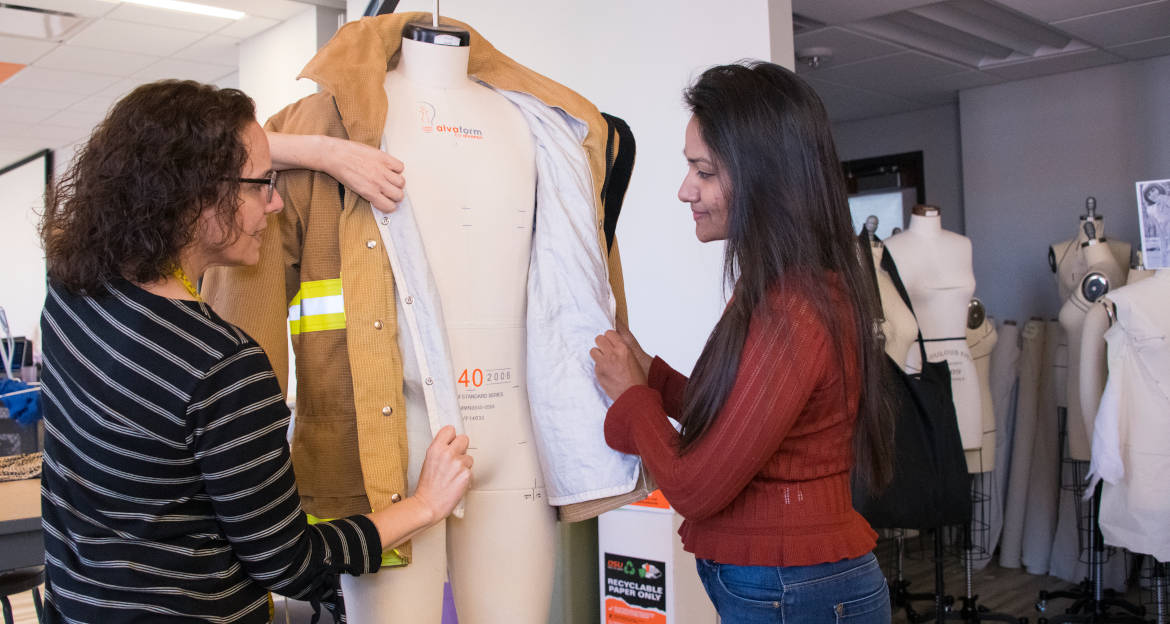
Protecting First Responders
Thursday, December 10, 2020
Far from the flames of burning fires, Oklahoma State University textile researchers are investigating how to make clothing and equipment safer for firefighters.
Dr. Sumit Mandal, an assistant professor in the Department of Design, Housing and Merchandising, in collaboration with Dr. Rob Agnew, an assistant professor of fire protection and safety engineering technology, burns clothing to study the heat and chemicals produced by fabric materials. Mandal has published nearly 30 journal articles about fire and textile safety and joins a diverse team of fire safety researchers working to meet an important need.
“Based on the previous reports from the National Fire Protection Association, between 64 and 70 firefighters die and 40,000 to 50,000 firefighting injuries happen in the U.S. every year,” Mandal said. “The purpose of this research is to give first responders the protection and safety they deserve.”
While Mandal studies the material of firefighters’ clothing, Dr. Lynn Boorady, OSU professor and head of the Department of Design, Housing and Merchandising, has studied the clothing’s functionality. She considers whether clothing styles allow full movement and how clothing layers may trap heat.
“The No. 1 cause of death for firefighters is heatstroke,” Boorady said. “When they come out of very high heat, they have to unzip in order to dissipate the heat as fast as possible.”
Firefighting clothing protects from heat with three layers: a fireresistant outer layer maintains the integrity of the clothing in fire, a middle section serves as a moisture barrier and provides resistance to water and chemicals, and an inner layer acts as a thermal insulator. However, the effectiveness of these layers depends on whether the clothing fits properly.
For example, if a jacket is too short, a firefighter’s waist could be exposed to flames when reaching up. If gloves do not bend easily, firefighters may remove them to do a job quickly and accurately, risking heat exposure to their hands.
“While conventional firefighting equipment fits the larger population, it doesn’t fit the smaller population, such as for women,” Boorady said. “We have firefighters wearing gear that is too big for them, which means it’s also heavier and bulkier than it needs to be.”
Boorady uses a body scanner to measure firefighters’ body dimensions down to the millimeter. In only 20 seconds, four cameras take 250 measurements of the firefighter’s body, and a computer generates a digital avatar with exact dimensions. The data helps equipment manufacturers better meet client needs.
“The measurements are so detailed, I could even body scan an entire football team and tell what role each person is in because they have different body types,” Boorady said.

Even after exact measurements are taken, firefighters may still be uncomfortable if their clothing’s material is not properly transferring their metabolic heat and sweat vapor. Mandal uses a cone calorimeter capable of testing material up to 2000 degrees Fahrenheit to test the fabric itself in extreme situations.
“We look at how quickly cloth loses mass and how much heat it produces,” Mandal said. “We also analyze the different toxic gases to determine if chemicals are emitted that could cause cancer.”
He then uses a Kawabata machine to digitally analyze fabric qualities.
“Mandal looks at the drape, how well it survives heat, how comfortable it is,” Boorady said. “Can he add any sort of breathability, or any materials that will dissipate heat faster and distribute it more?”
Outside of fire-resistant clothing, the technologies have broader applications for online fashion shopping.
“One day, you could upload your avatar to a website, and the company could start to suggest things for you,” Boorady said. “We won’t make anything until you buy it, and then when we produce on demand it will help with sustainability — less clothing in the landfills, less inventory to get rid of.”
Students also have access to the technology used by researchers in the Textiles and Apparel Science Lab.
While Boorady and Mandal study fireresistant clothing, they also hope the technologies inspire students’ broader interests in functional fashion.
“It’s not only about how you look, but rather how it feels and how it functions on your body,” Boorady said.
MEDIA CONTACT: Brittany Bowman| 540-908-0929 | brittany.bowman@okstate.edu
